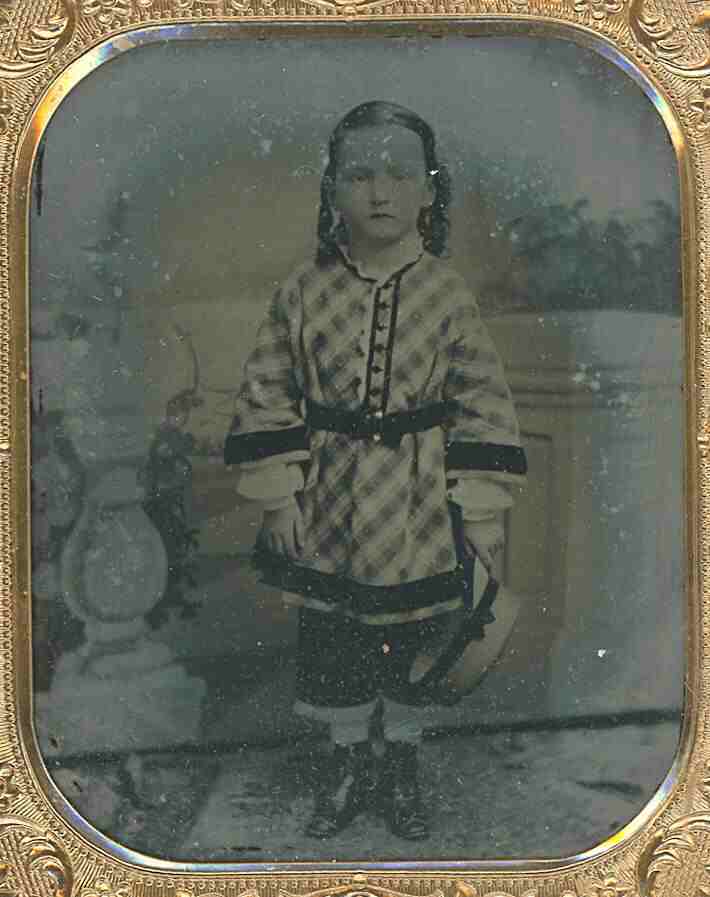

Figure 1.--While we do not know this boy's name or where he was from, there is not doubt in our mind that the child was a boy, primarily because of his clothes. One especially important aspeect of this portrait is the military-style cap he is holding. Often headwear is missing in these old photographs.
|
Boys' Ringlet Curls: Unidentified American Boy (1850s)
Here we have a wonderful ambrotype of an American boy. Unfortunately we do not know his name. This is often the case of anbrotypes and daguerrotypes. They came in cases, but there was no convient place to write a notation. The portrait is also not dates, but we would guess was taken in the mid-1850s. The ambrotype by this time was beginning to replace the more expensive daguerrotype. While we do not know this boy's name or where he was from, there is not doubt in our mind that the child was a boy, primarily because of his clothes. One especially important aspeect of this portrait is the military-style cap he is holding. Often headwear is missing in these old photographs. I have never seen this style of cap before, but our archive of 1850s images is fairly limited. The boy has ringlet curls, but they are a little on the sgragly side--not the emacuately done curls we see in the 1880s. I am not sure why his hair was done like this, we note girls at the time with full ringlet curls. The boy wears a plaid tunic suit. This one is done in a sort of plid, presumably to mimic a Scottish kilt, a stule that was becoming popular for boys in Britain. Notice the shortened sleeves and ballon sleves on the blouse. The boy wears short-length pants. It is a little difficult to tell, but they seem rather a transition between more childish pantalettes and more boyish trousers. Note the outfit is being worn with white hosiery. We are not sure about the length of the the hosiery.
Here we have a wonderful ambrotype of an American boy. The ambrotype was an important advance on the daguerrotypeand significantly reduced the cost of a portrait. There were other advantages to the ambrotype, especially the shorter exposure times. Like the daguerreotype, however, it was not possible to have copies printed as there was no negative. Knowing the type of portrait is useful in dating images like this. Ambrotypes forst appeared in the eaely 1850s.
The Boy
Unfortunately we do not know the boy's name. This is often the case of anbrotypes and daguerrotypes. They came in cases, but there was no convient place to write a notation. The outfit suggests that the boy came from an affluent family. He looks to be about 5 years of age.
Chronology
The portrait is also not dates, but we would guess was taken in the mid-1850s or perhaps the 60s. The ambrotype by this time was beginning to replace the more expensive daguerrotype. The fact that the image is an anbrotype is a strong indicator that the portrait was taken in the 1850s. The 1860s is possible, but the clothing styles seem more like the 50s than the 60s. Pne interesting indicator here is trhe background. Many dahuerrotypes and ambrotypes taken in the 850s did not have a background like this. The background seems more like the ones we see in 1860s CDVs and cabinent cards. This leads us to believe that the portrait here may have been taken in the late 1850s, perhaps even the early 60s.
Location
While we do not know this boy's name or where he was from, there is not doubt in our mind that the child was a boy, primarily because of his clothes.
Hair
The boy has ringlet curls, but they are a little on the sgragly side--not the emacuately done curls we see in the 1880s. I am not sure why his hair was done like this, we note girls at the time with full ringlet curls.
Clothing
One especially important aspeect of this portrait is the military-style cap the boy is holding. Often headwear is missing in these old photographs. I have never seen this style of cap before, but our archive of 1850s images is fairly limited. The boy wears a plaid tunic suit. This one is done in a sort of plid, presumably to mimic a Scottish kilt, a stule that was becoming popular for boys in Britain. Notice the shortened sleeves and ballon sleves on the blouse. The boy wears short-length pants. It is a little difficult to tell, but they seem rather a transition between more childish pantalettes and more boyish trousers. Note the outfit is being worn with white hosiery. We are not sure about the length of the the hosiery.
HBC

[Return to the Main ringlet curl individual American boys page]
[Return to the Main ringlet curl American page]
[Return to the Main ordinary people biography page]
[Teturn to the Main ringlet curl page]
[Return to the Main curl page]
[Bangs]
[Long hair]
[Hair bows]
[Caps]
[Collar bows]
[Tunics]
Navigate the Boys' Historical Clothing Web Site:
[Introduction]
[Activities]
[Biographies]
[Chronology]
[Clothing styles]
[Countries]
[Bibliographies]
[Contributions]
[FAQs]
[Glossaries]
[Satellite sites]
[Tools]
[Boys' Clothing Home]
Created: 4:27 PM 11/9/2006
Last edited: 8:54 PM 11/9/2006



